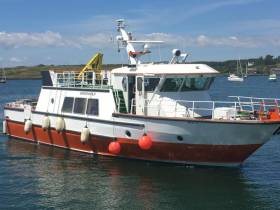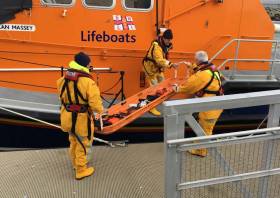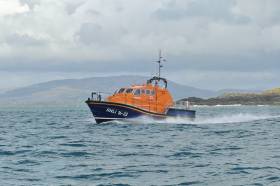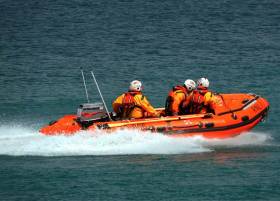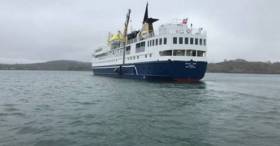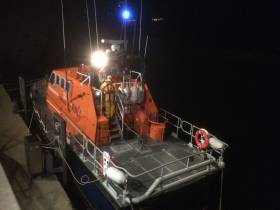Displaying items by tag: Cape Clear Island
Baltimore Lifeboat Called for Medevac From Cape Clear Island
Baltimore RNLI were called out to provide a medical evacuation on Friday morning (28 October) from Cape Clear Island off the coast of West Cork.
The volunteer lifeboat crew launched their all-weather lifeboat The Alan Massey at 10.44am following a request from the Irish Coast Guard to provide a medevac for a resident of the island.
The Baltimore crew arrived at North Harbour on Cape Clear Island at 11.08am where the casualty and the island nurse were waiting. The casualty was transferred onto a stretcher and then onboard the lifeboat, which departed at 11.30am and arrived in Baltimore half an hour later.
The casualty was then transferred from the lifeboat to the waiting ambulance and care was handed over to the HSE ambulance crew.
Conditions during the call-out were windy with a south-westerly Force 4-5 wind and a large sea swell.
Speaking later, Baltimore RNLI volunteer lifeboat press officer Kate Callanan said: “Baltimore RNLI often provide medical evacuations to residents of islands off the coast of West Cork. If you find yourself in need of medical assistance whilst on an island, call 999 or 112 and ask for the coastguard.”
There were seven volunteer crew onboard the lifeboat: coxswain Aidan Bushe, mechanic Cathal Cottrell and crew members Micheal Cottrell, Jerry Smith, Pat Collins, Stuart Musgrave and Emma Geary.
West Cork's Cape Clear Island Plans New Heritage and Fastnet Centre
A 'Heritage & Fastnet Centre' is scheduled to open in Summer 2024 on Cape Clear Island, located on the West Cork coast.
The development of the centre was celebrated by raising flags at the proposed site during a 'Flags Day' event. Micheal ó Ceadagáin, one of the island's oldest residents and one of the Iron Men of Cape Clear, raised the Fastnet Rock and Lighthouse flag, signifying Cape Clear's close relationship with the Fastnet.
Throughout the 1960s, Micheál and his fellow Iron Men delivered bags of coal up the 99 steps to the Fastnet Lighthouse. He has dedicated his life to working for the island community, serving as Chairperson and Manager of Cape Clear Coop, among other roles.
The Cape Clear Flag was also raised near St Ciarán Gallán and the Holy Well in North Harbor, commemorating the island's 5,000-year history represented by the Cape Clear Stone. Éamon Lankford spent 40 years collecting artefacts from the island and conducting extensive research on its history and folklore, producing a collection of publications about Oileán Cléire.
 The Cape Clear Island Centre is being developed
The Cape Clear Island Centre is being developed
Islanders are hopeful for the return of the Cape Clear Stone, which is currently housed in a museum in Cork City.
Flags were also raised for the new children's playground on Cape Clear, the Fastnet Rock & Lighthouse, and the O'Drisocoll Flag, in honour of the O'Driscoll heritage, with the O'Driscoll Worldwide Archives set to be kept at the new Centre. The island community aims to develop a Heritage Centre to gain national and international recognition.
The first phase includes maritime heritage, local historic shipwrecks, and a tower showcasing the history of the harbour, Church, and Castle, among other features.
Many individuals and groups are contributing to the island's progress.
Baltimore RNLI lifeboat was called out to provide a medical evacuation earlier this morning from Cape Clear Island off the coast of West Cork.
The volunteer lifeboat crew launched their all-weather lifeboat at 8.30 am, following a request from the Irish Coast Guard to provide a medical evacuation for a woman living on the island.
The Baltimore all-weather lifeboat crew arrived at North Harbour on Cape Clear Island at 8.54 am and transferred the casualty onboard the lifeboat. The lifeboat departed Cape Clear Island at 8.56 am and returned to the station in Baltimore, arriving at 9.17 am. The casualty was then handed over to the care of the HSE Ambulance crew.
There were five volunteer crew onboard the lifeboat, Coxswain Aidan Bushe, Mechanic Cathal Cottrell and crew members Don O’Donovan, Micheal Cottrell and Pat Collins.
Conditions during the call out were windy but calm with a south easterly force 3-4 wind and very little sea swell.
Baltimore RNLI were called out to provide a medical evacuation this afternoon (Sunday 10 October) from Cape Clear Island off the coast of West Cork.
The volunteer lifeboat crew launched their all-weather lifeboat at 2.39 pm, following a request from the Irish Coast Guard to provide a medical evacuation for a woman living on the island.
The Baltimore all-weather lifeboat crew arrived at North Harbour in Cape Clear Island at 2.58 pm The casualty was transferred onboard the lifeboat and they departed the Island at 3.14 pm. The lifeboat returned to the station in Baltimore, arriving at 3.37pm and the casualty was handed over to the care of the HSE Ambulance crew at 3.43 pm.
There were five volunteer crew onboard the lifeboat, Coxswain Jerry Smith, Mechanic Sean McCarthy and crew members Colin Whooley, Don O'Donovan and Jim Baker. Conditions at sea during the call out were calm with a westerly force 3 wind, no sea swell and excellent visibility.
#FerryNews - A new fast ferry has just been commissioned for Cape Clear Island Ferries after completing various surveys and sea trials and a number of modifications to comply with Irish MSO standards.
Dún na Séad II was purchased in Norway earlier this year and arrived in Baltimore in April. It is capable of speeds of up to 20 knots with an operating speed of 18 knots and has a crane and cargo capacity of 6 tons.
Features include airline-style seating with large windows in a comfortable saloon with air conditioning and other features.
Licensed for 97 passengers with upper deck seating that affords outstanding 360-degree views of Roaringwater Bay, the ferry marks a substantial investment for the Cape Clear Island Ferries which owns three other passenger vessels: Dún an Óir II, Dún Aengus and Cailín Óir.
Dún na Séad II will operate primarily on the Schull—Cape Clear route but it is planned to use her occasionally on the Baltimore—Cape Clear route which is the main year-round service to the island.
Current traveling times of 45 minutes from both Schull and Baltimore will be halved when this vessel is in use.
Cape Clear Island Ferries says that the larger vessel together with the shorter journey time more than doubles the potential passenger capacity, and its focus will be on larger groups, bus and coach tours as well as building relationships with complementary service providers.
The ferry company has in recent years focused on soft adventure tourism surrounding the Fastnet Rock Lighthouse, which has shown double-digit growth over the past four years.
Considered the ‘Gateway to the Fastnet’, Cape Clear Island regularly welcomes passengers arriving from both Schull and Baltimore to see the famous rock.
While the company does not offer specific whale-watching trips, whale and dolphin sightings are a frequent occurrence in the area.
Cape Clear Ferries is owned by local shareholders on Cape Clear Island and Baltimore and its management, shareholders and staff are all from the immediate area. The business was established in 2007.
Baltimore Lifeboat In Medevac From Cape Clear Island
#RNLI - Baltimore RNLI carried out a medical evacuation yesterday afternoon (Wednesday 25 July) from Cape Clear Island off the coast of West Cork.
The volunteer lifeboat crew launched their all-weather lifeboat following a request from the Irish Coast Guard at 1.42pm to provide medical assistance and evacuation to an islander living on Cape Clear.
Arrived in North Harbour at Cape Clear at 2.05pm, four of the volunteer crew went to the casualty’s location to assist with transfer and casualty care.
Once ready, the casualty was brought onboard Baltimore lifeboat and they departed the island at 3.07pm. The lifeboat returned to station in Baltimore and handed the casualty over to the care of HSE ambulance crew at 3.51pm.
Conditions at sea during the call out were relatively calm, with a south-westerly Force 3-4 wind and one-metre sea swell.
Speaking after the callout, Baltimore RNLI volunteer lifeboat press officer Kate Callanan said: ‘Medical evacuations — medevacs — are a regular service that Baltimore RNLI provide between the mainland and islands, and also between the mainland and private and commercial boats at sea.
“If you find yourself in need of medical assistance, call 999 or 112 and ask for the coastguard.”
There were six volunteer crew onboard the lifeboat: coxswain Aidan Bushe, mechanic Cathal Cottrell and crew members Eoin Ryan, Kieran Collins, Emma Lupton and Don O’Donovan.
#RNLI - Baltimore RNLI carried out a medevac yesterday morning (Monday 21 May) from Cape Clear Island off the coast of West Cork.
The volunteer lifeboat crew were asked to launch their all-weather lifeboat following a request from the Irish Coast Guard at 7.53am to provide medical assistance and evacuation to a man living on the island.
The all-weather lifeboat arrived in Cape Clear at 8.25am and the casualty was transferred to the care of the volunteer crew onboard.
The lifeboat then returned to Baltimore lifeboat station at 8.55am and handed the casualty over to the care of HSE ambulance crew once they arrived at the station.
Conditions at sea during the shout were flat calm with a north-easterly Force 3 wind.
There were seven volunteer crew onboard the lifeboat: coxswain Aidan Bushe, mechanic Cathal Cottrell and crew members Brendan Cottrell, Micheal Cottrell, Jerry Smith, Emma Lupton and Don O’Donovan. Kieran Cotter provided shore crew assistance at the lifeboat house.
Speaking following the callout, Baltimore RNLI volunteer lifeboat press officer Kate Callanan said: “Baltimore lifeboat regularly provides medical assistance and transfers for people living, working or holidaying on the islands.
“This call is the third medical evacuation for Baltimore RNLI in the past two weeks.
“Always remember, if you find yourself at sea or on an island in need of medical assistance, call 999 or 112 and ask for the coastguard.”
RNLI Lifeboats In Medevac Shouts At Baltimore & Wicklow
#RNLI - Baltimore RNLI carried out a medevac on Saturday night (12 May) from Cape Clear Island off the coast of West Cork.
The volunteer crew were requested to launch their all-weather lifeboat by the Irish Coast Guard at 8.05pm to provide medical assistance and evacuation to a man working on the island.
Arriving in Cape Clear at 8.24pm, the RNLI volunteers transferred the casualty onto the lifeboat and returned him to Baltimore lifeboat station, whee he was handed over to the care of a waiting HSE ambulance crew.
Conditions at sea during the shout were calm with a south-westerly Force 3 wind and half-metre sea swell.
“So far this year medical evacuations make up a high percentage of the call outs for Baltimore lifeboat,” said Kate Callanan, Baltimore RNLI volunteer lifeboat press officer.
“Acting as an ambulance between the islands off the coast of West Cork is a vital service and our volunteer crews are trained to a high standard in first aid and casualty care.
“If you find yourself at sea or on an island in need of medical assistance, call 999 or 112 and ask for the coastguard.”
Hours later, Wicklow RNLI’s inshore lifeboat crew were alerted by pager shortly after 3.10pm yesterday afternoon (Sunday 13 May) to assist in the medic of an injured sailor in the town’s harbour.
The sailor was being treated on a yacht by first responders and HSC paramedics at the East pier after he sustained injuries while sailing in Wicklow Bay.
The lifeboat was requested to launch in case the casualty was seriously injured and needed to be evacuated from the yacht to a more suitable location for transfer to an ambulance.
The lifeboat, with helm Alan Goucher and crew Terry Sillery and Paul Sillery, was about to launch when lifeboat operations manager Des Davitt was made aware that the casualty was assisted up a ladder onto the pier after being treated by paramedics, and no further assistance was required.
Cape Clear Port of Call A First By Cruise Ship
#CruiseLiners - For the first time ever a cruise ship called to the West Cork island of Cape Clear last Thursday morning with a group of 70 bird watchers.
Guests on the cruise ship Ocean Nova, writes the Evening Echo, were escorted by guides from Birdwatch Ireland who have a manned bird observatory on the island, and visited some of the island’s prime birdlife, wildlife, and marine life viewing spots.
While the main focus of the visit was birdwatching, they also took time to visit the island’s museum which depicts life on Cape Clear, past and present, and view its impressive exhibit about the building of the iconic Fastnet Rock.
Upon departure, the ship sailed around Fastnet and entered Schull Harbour, another first.
From there, coaches brought passengers to the Mizen Head Signal Station and Visitor Centre where they enjoyed not only the scenery, but observed the bird and marine life in this area.
To read more on the story, click here.
Baltimore Lifeboat In Medevac From Cape Clear Island
#RNLI - Baltimore RNLI carried out a medevac on Sunday night (6 August) for a student on Cape Clear Island off the coast of West Cork.
The volunteer lifeboat crew were tasked to launch their all-weather lifeboat at 10.11pm to provide medical assistance and evacuation to a female student who received an injury after a fall.
Once on scene, three of the volunteer crew went ashore and were brought by minibus to the casualty. There they administered care before transferring the injured girl back to the all-weather lifeboat.
The lifeboat then returned to Baltimore lifeboat station at 11.40pm and handed the casualty over to the care of waiting HSE ambulance crew.
Conditions at sea during the shout were calm with a westerly Force 3-4 wind and one-metre sea swell.
Speaking following the callout, Baltimore RNLI volunteer lifeboat press officer Kate Callanan said: “The lifeboat is often called upon to act as an ambulance service between the islands and mainland, and our volunteer crews are trained to a high standard in first aid and casualty care.
“If you find yourself at sea or on an island in need of medical assistance, call 999 or 112 and ask for the coastguard. We wish [the casualty] a full and speedy recovery.”
The crew on this callout comprised coxswain Kieran Cotter, mechanic Brian McSweeney and crew members Jerry Smith, Pat Collins, Diarmuid Collins, Jim Griffiths and Ryan O’Mahony.
Micheal Cottrell, Rianne Smith, Eoin Ryan, Sean McCarthy, Don O’Donovan and David Ryan provided shore crew assistance at the lifeboat house.



























